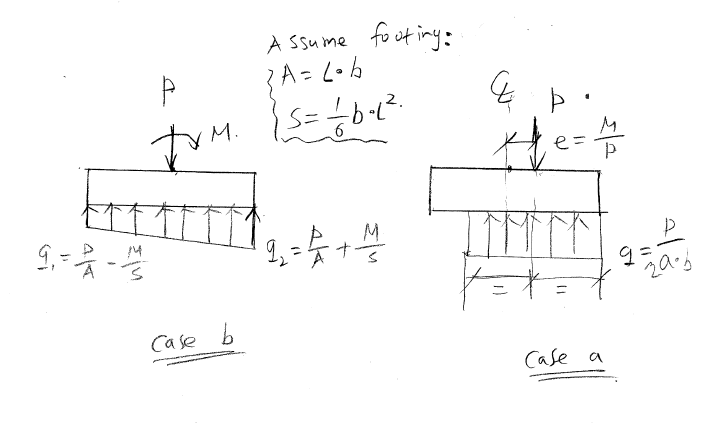MagicFarmer
Structural
- May 2, 2017
- 38
Good afternoon,
I am working through an eccentrically loaded footing problem and have some questions.
In Reinforced Concrete - Mechanics and Design (MacGregor and Bartlett), the book states:
"For the structural design of eccentrically loaded footings such as those for retaining walls or bridge abutments, the Ontario Highway Bridge Design Code requires that two pressure distributions be considered. The first of these is a uniform pressure over a portion, Ap, of the contact surface. The area Ap is chosen such that the centroid of Ap and the resultant of the applied loads coincides. The second pressure distribution is a linearly varying distribution, again, with the resultant soil pressure coincident with the resultant of the applied loads."
The clauses in the OHBDC state:
6.7.3 Pressure distribution
6.7.3.1 Effective area
For proportioning of concentrically loaded footings, a contact pressure of uniform intensity at the ULS shall
be assumed.
For eccentrically loaded footings, an equivalent effective area with a contact pressure of uniform
intensity shall be assumed such that the centroid of the area coincides with the vertical component of the
factored load.
6.7.3.2 Pressure distribution at the ULS for structural design
For the structural design of footings, the more critical of the following shall be considered:
(a) a uniform pressure distribution whose magnitude shall not be more than the factored geotechnical
resistance; or
(b) a linear pressure distribution where the maximum bearing pressure could be greater than the
factored geotechnical resistance.
6.7.3.3 Pressure distribution at the SLS
A linear distribution of contact pressure at the SLS shall be assumed. Tension at the interface between the
footing and the soil or rock shall not be assumed.
6.7.3.4 Eccentricity limit
In the absence of detailed analysis at the ULS for soil or rock, the eccentricity of the resultant of the
factored loads at the ULS acting on a foundation, as shown in Figure 6.4, shall not exceed 0.30 times the
dimension of the footing in the direction of the eccentricity being considered.
The "could be greater" in b) confuses me... I researched online, and there is a FEMA document online that uses the uniform pressure for plastic design only. I just spoke with a local soils engineer, and they stated that they don't assign plastic soil bearing pressure values. I have looked at this problem for a couple days now and can not find a case in which the triangular pressure distribution results in a lower bearing pressure. Could someone please explain how to implement or when to use the uniform soil pressure in design, and how this relates to standard engineering practice with the SLS and ULS bearing pressure values that would appear in a typical geotechnical report?
Thank you in advance.
I am working through an eccentrically loaded footing problem and have some questions.
In Reinforced Concrete - Mechanics and Design (MacGregor and Bartlett), the book states:
"For the structural design of eccentrically loaded footings such as those for retaining walls or bridge abutments, the Ontario Highway Bridge Design Code requires that two pressure distributions be considered. The first of these is a uniform pressure over a portion, Ap, of the contact surface. The area Ap is chosen such that the centroid of Ap and the resultant of the applied loads coincides. The second pressure distribution is a linearly varying distribution, again, with the resultant soil pressure coincident with the resultant of the applied loads."
The clauses in the OHBDC state:
6.7.3 Pressure distribution
6.7.3.1 Effective area
For proportioning of concentrically loaded footings, a contact pressure of uniform intensity at the ULS shall
be assumed.
For eccentrically loaded footings, an equivalent effective area with a contact pressure of uniform
intensity shall be assumed such that the centroid of the area coincides with the vertical component of the
factored load.
6.7.3.2 Pressure distribution at the ULS for structural design
For the structural design of footings, the more critical of the following shall be considered:
(a) a uniform pressure distribution whose magnitude shall not be more than the factored geotechnical
resistance; or
(b) a linear pressure distribution where the maximum bearing pressure could be greater than the
factored geotechnical resistance.
6.7.3.3 Pressure distribution at the SLS
A linear distribution of contact pressure at the SLS shall be assumed. Tension at the interface between the
footing and the soil or rock shall not be assumed.
6.7.3.4 Eccentricity limit
In the absence of detailed analysis at the ULS for soil or rock, the eccentricity of the resultant of the
factored loads at the ULS acting on a foundation, as shown in Figure 6.4, shall not exceed 0.30 times the
dimension of the footing in the direction of the eccentricity being considered.
The "could be greater" in b) confuses me... I researched online, and there is a FEMA document online that uses the uniform pressure for plastic design only. I just spoke with a local soils engineer, and they stated that they don't assign plastic soil bearing pressure values. I have looked at this problem for a couple days now and can not find a case in which the triangular pressure distribution results in a lower bearing pressure. Could someone please explain how to implement or when to use the uniform soil pressure in design, and how this relates to standard engineering practice with the SLS and ULS bearing pressure values that would appear in a typical geotechnical report?
Thank you in advance.

